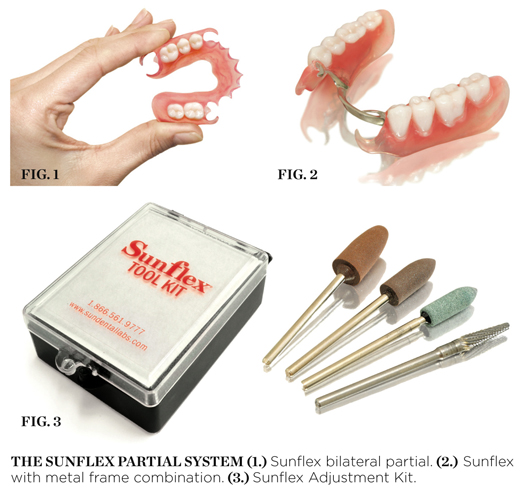Sunflex® Partials: Flexibility Beyond the Patient’s Experience
Unique resin formula guarantees The Perfect Fit™.
With features that surpass the standard benefits of a regular flexible partial, Sunflex is considered one of the finest solutions in partial denture treatment available today. Prescribed by thousands of dentists worldwide, Sunflex is denser and more stain-resistant that other flexible partials, and does not warp, discolor, or become brittle.
Providing exceptional compressive, impact, and bending strength, Sunflex is guaranteed for life for breakage, and can be used as a bilateral (Figure 1) or unilateral denture. It is an excellent implant healing partial, and can also be prescribed in combination with cast metal frameworks to provide enhanced stability for free end-saddle cases (Figure 2).
Sunflex Partials are made of a specialized form of nylon in the family of superpolymides, a very pure nylon that is resistant to chemical deterioration and is virtually unbreakable. The biocompatible resin is uniquely formulated to offer the perfect level of flexibility and translucency, guaranteeing maximum comfort and enhanced esthetics.
Impression/Insertion
The distinctiveness of Sunflex begins with impression-taking and insertion procedures. No tooth preparation is required, and a master cast poured immediately from an alginate impression must be sent to the laboratory along with opposing model and bite registration.
Sunflex remains translucent after processing, readily adapting to a variety of natural tissue shades. The resin is available in five different tones, and complimentary shade guides are available upon request.
In order to guarantee a smooth placement and good adaptation with the natural tissues in the patient’s mouth, the Sunflex partial must be immersed in very hot tap water for about 2 minutes prior to insertion. Once it has cooled to a tolerable temperature, it is then inserted gently in the patient’s mouth. If a clasp is too tight, it can be slightly loosened if immersed in hot water for 30 seconds and bent outward under cold water. If a clasp is loose, the same procedure can be used, while bending it inward. One of the many benefits of Sunflex is that it has great memory, and the resin will retain its position once cooled.
Chairside Adjustments
The benefits of the Sunflex resin go beyond the patient’s experience, and its distinct physical properties make it one of the most “dentist-friendly” flexible partials available. If necessary after insertion procedure, further chairside adjustments can be easily made without gumming or flaking of the material, and the Sunflex Tool Kit, a set of burs especially designed for the Sunflex thermoplastic resin (Figure 3), is recommended for upmost results.
To grind down the edges, the cross-cut carbide bur is recommended. The green silicone-carbide abrasive bur provides fine adjustments with little roughness on the surface, and is used to relieve tissue-contacting areas, reduce periphery edges, and diminish insertion and removal difficulty. The green and brown rubber point provides even smoother reduction, and the brown rubber point rubberizes, smoothes, and pre-polishes the surface.
Because too much pressure could burn or distort the partial, it is crucial to repeatedly vary the contact point and use the lowest speed on the handpiece for all burs, with rapid back-and-forth light, scraping movements.
Although infrequent when the green point is used properly, polishing can be done with a coarse pumice and brown tripoli on a soft rag wheel, followed by the use of an acrylic-polishing mix for high luster.
Additions/Reline/Rebase
Besides easy in-office adjustability, the Sunflex resin allows for the addition of teeth and clasps without demarcation lines and, although relatively infrequent due to its ability to adapt to subtle changes in the mouth, the partial can be relined or rebased in the laboratory. No other materials should be used when adding to the partial.
For the addition of tooth, clasp, and saddle, an alginate impression with the partial in place should be taken, poured immediately, and sent to the laboratory with instructions. For a reline or rebase, the tissue side of the partial must be clean and all adhesives must be removed. A rubber-base impression in a closed-mouth position is taken, followed by an alginate pick-up impression that is poured immediately, and it is crucial that the partial is not separated from the model when sent to the laboratory.
Understanding the distinctive features of Sunflex in comparison to other partial dentures, and how they translate into preparation procedures and adjustment techniques, is vital to the success of a Sunflex case.
For more information, contact:
Sun Dental Labs
Phone: 866-561-9777
Web: https://www.sundentallabs.com
Disclaimer
The preceding material was provided by the manufacturer. The statements and opinions contained therein are solely those of the manufacturer and not of the editors, publisher, or the Editorial Board of Inside Dentistry. The preceding is not a warranty, endorsement, or approval for the aforementioned products or services or their effectiveness, quality, or safety on the part of Inside Dentistry or AEGIS Communications. The publisher disclaims responsibility for any injury to persons or property resulting from any ideas or products referred to in the preceding material.





